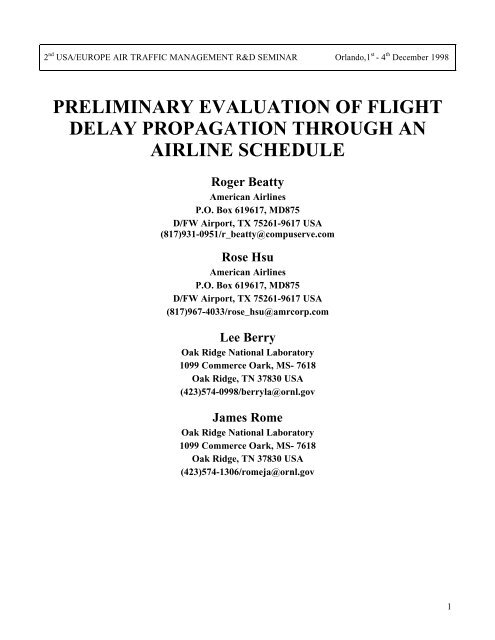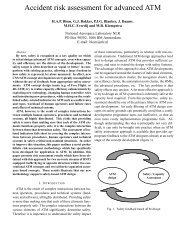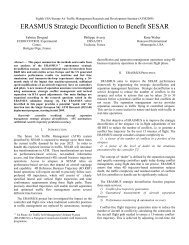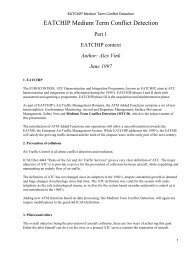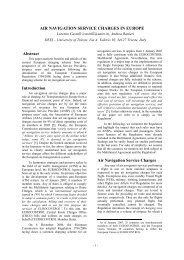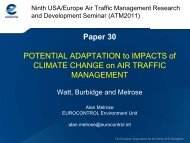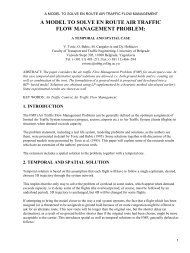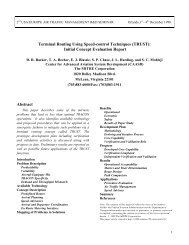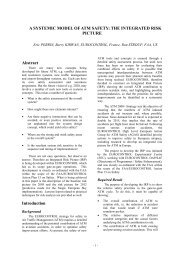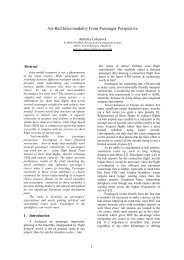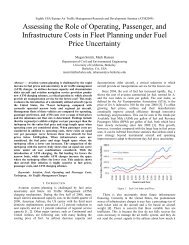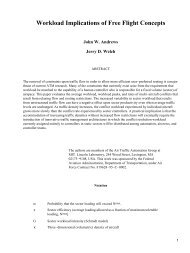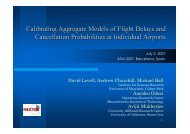preliminary evaluation of flight delay propagation ... - ATM Seminar
preliminary evaluation of flight delay propagation ... - ATM Seminar
preliminary evaluation of flight delay propagation ... - ATM Seminar
You also want an ePaper? Increase the reach of your titles
YUMPU automatically turns print PDFs into web optimized ePapers that Google loves.
2 nd USA/EUROPE AIR TRAFFIC MANAGEMENT R&D SEMINAR Orlando,1 st - 4 th December 1998PRELIMINARY EVALUATION OF FLIGHTDELAY PROPAGATION THROUGH ANAIRLINE SCHEDULERoger BeattyAmerican AirlinesP.O. Box 619617, MD875D/FW Airport, TX 75261-9617 USA(817)931-0951/r_beatty@compuserve.comRose HsuAmerican AirlinesP.O. Box 619617, MD875D/FW Airport, TX 75261-9617 USA(817)967-4033/rose_hsu@amrcorp.comLee BerryOak Ridge National Laboratory1099 Commerce Oark, MS- 7618Oak Ridge, TN 37830 USA(423)574-0998/berryla@ornl.govJames RomeOak Ridge National Laboratory1099 Commerce Oark, MS- 7618Oak Ridge, TN 37830 USA(423)574-1306/romeja@ornl.gov1
AbstractAirline <strong>flight</strong> schedules are particularly sensitive toindividual <strong>flight</strong> <strong>delay</strong>s because <strong>of</strong> the manner inwhich operating resources are linked together.Among the connective resources affected by <strong>delay</strong>ed<strong>flight</strong> operations are crews, aircraft. passengers andgate space. Because <strong>of</strong> this branching connectivitythe <strong>delay</strong> <strong>of</strong> one <strong>flight</strong>s tends to propagate rapidlydown line to many others. In order to evaluate aninitial <strong>flight</strong> <strong>delay</strong> on an airline operating schedulethis paper proposes the concept <strong>of</strong> a Delay Multiplier(DM).Using American Airlines crew and aircraftconnectivity through an actual airline operatingschedule the DM demonstrates the value <strong>of</strong> <strong>delay</strong> (or<strong>delay</strong> reduction) on the operating schedule as awhole. The relationship between the duration <strong>of</strong>initial <strong>delay</strong>, the time <strong>of</strong> day <strong>of</strong> the <strong>delay</strong>occurrences and airline schedule connectivity areused to calculate the value <strong>of</strong> the DM.Specifically, this process was developed to evaluatechanges in the FAA's Air Traffic ManagementGround Delay Program procedures.Background1. The ProblemWhen the <strong>flight</strong> arrival demand exceeds an airport'sacceptance capacity, it is the job <strong>of</strong> the FAA's AirTraffic Control System Command Center(ATCSCC) to control demand. This is <strong>of</strong>ten donethrough the use <strong>of</strong> a technique called the GroundDelay Program (GDP). Under this programATCSCC issues Controlled Times <strong>of</strong> Arrival (CTAs)to <strong>flight</strong>s still on the ground but destined to arrive atthe constrained airport to ensure the airport capacityis not exceeded. GDP can produce <strong>delay</strong>s forindividual <strong>flight</strong>s ranging from a few minutes toseveral hours. These <strong>delay</strong>s are <strong>of</strong> concern to anyuser, but are most disruptive to airline operatorswhose schedules are made up <strong>of</strong> tightly connectedoperating resources (i.e. aircraft and crews).Intuitively, large <strong>delay</strong>s early in the operating dayare most disruptive, while short <strong>delay</strong>s (or <strong>delay</strong>s latein the day) have little or no <strong>propagation</strong> through theschedule.To better understand the total effect <strong>of</strong> airline <strong>flight</strong><strong>delay</strong>s produced by ATCSCC GDPs, AmericanAirlines and Oak Ridge National Laboratorycollaborated on a joint study to see if a numerical"<strong>delay</strong> multiplier" (DM) could be derived that wasbased on the length <strong>of</strong> the initial <strong>delay</strong> and the time<strong>of</strong> day it occurred.This was not an attempt to predict the actualdownline effect any given <strong>flight</strong> <strong>delay</strong> wouldproduce, but rather to develop a "generic" total value<strong>of</strong> both the initial <strong>delay</strong> and its continuingconsequences on the airline schedule. This totalvalue could then be used in the <strong>evaluation</strong> <strong>of</strong> changesin GDP procedures.It seemed obvious to those that operate airlineschedules that reducing a 60 minute <strong>delay</strong> to 30minutes is much more valuable than reducing a 30minute <strong>delay</strong> to zero. The question is: How does thevalue <strong>of</strong> initial <strong>delay</strong> reduction vary based on boththe length <strong>of</strong> the initial <strong>delay</strong> and the time <strong>of</strong> day atwhich it occurs?It is important to note that, for an airline, the "value"<strong>of</strong> <strong>delay</strong> is not just its effect on an individualairframe but its effect on the operating schedule. Itis this schedule that is the primary product <strong>of</strong>feredto the traveling public. Passengers do not go out tothe airport to fly on a specific airplane or with aspecific crew. They go to catch the two o'clock<strong>flight</strong> to Chicago which is promised in the airline'spublished schedule. A significant part <strong>of</strong> the airline'sday-to-day operational effort is expended in theattempt to keep that promise.2. The Concept <strong>of</strong> Delay Multiplier (DM)To establish the value <strong>of</strong> the DM we decided toanalyze the conductivity <strong>of</strong> crew sequences andaircraft sequences though the American Airlines<strong>flight</strong> schedule. While these are the obvious andprimary assets needed to operate <strong>flight</strong>s, there areother resources that are affected by <strong>delay</strong>ed <strong>flight</strong>operations that were not considered due to theircomplexity. Most notably, the affect <strong>of</strong> <strong>delay</strong>edoperations on passengers, cargo and gate space werenot considered. Each <strong>of</strong> these can induce <strong>delay</strong>s inother <strong>flight</strong>s. Therefore we believe our calculatedDMs based on crew and aircraft only to be highlyconservative.The concept <strong>of</strong> Delay Multiplier can be consideredas that value, which when multiplied by the initial<strong>delay</strong>, would yield all <strong>of</strong> the potential downline2
<strong>delay</strong>s (produced by resource connectivity) plus theinitial <strong>delay</strong>, or, total <strong>delay</strong>. This could be shown as:DM = (I+D)/IWhere: DM= Delay Multiplier I= Initial <strong>delay</strong> andD= Down line <strong>delay</strong> (all values <strong>of</strong> <strong>delay</strong> are inminutes)For example, a <strong>flight</strong> into San Fransico (SFO) is<strong>delay</strong>ed 30 minutes. It <strong>delay</strong>s 2 <strong>flight</strong>s out <strong>of</strong> SFO,one 10 minutes awaiting a crew and another 5minutes awaiting the aircraft. In this case the initial<strong>delay</strong> is 30 minutes and the downline <strong>delay</strong> is 15(10+5) minutes so the <strong>delay</strong> multiplier would be 1.5.1.5 = (30+15)/30As long as the resource connectivity and minimumturn time are known the initial <strong>delay</strong> can be variedby time increments, the downline <strong>delay</strong>s recalculatedand new <strong>delay</strong> multipliers derived.3. The Proposed Departure ReportAmerican Airlines Operations personnel use acomputer display that allows airlines themselves to"what-if" with initial <strong>delay</strong>s and view the downlineeffects in a series <strong>of</strong> <strong>delay</strong> trees. This is done withwhat is called the "PRP" Command and a sample <strong>of</strong>this display is found in Figure 1 below.The Column headers are decoded as follows:FLT = <strong>flight</strong> number and departure dateDEP = 3 letter code <strong>of</strong> departure airportSKD = Scheduled gate departure time (localtime)PRJ = Projected departure time reflecting either amanual entry or as calculated fromminimum resource turn timeARV = 3 letter code or arrival airportSKA = Scheduled gate arrival time (local time)PRJ = Projected arrival time (local time)PRP 1237/22 ATL 0730 [ENTER]PRP 1237/22 ATL 0730FLT DEP SKD PRJ ARV SKA PRJ1237/22 ATL 0700 0730 DFW 0822 0852710/22 DFW 0906 0927 LGA 1316 1337FLT 1237/22 EQ 22/09271178/22 DFW 0910 0927 MIA 1300 1317FLT 1237/22 CP 22/0927 FA 22/0927333/22 LGA 1359 1412 ORD 1529 1542FLT 710/22 EQ 22/1412ENDFigure 1The abbreviated line below the <strong>flight</strong> lineexplains the reason for the projected downline<strong>delay</strong>. It shows the <strong>flight</strong> number <strong>of</strong> the <strong>delay</strong>edinbound <strong>flight</strong> and which resource(s) are causingthe downline <strong>delay</strong>. EQ stands for equipment(read aircraft), CP stands for Cockpit Crew andFA stands for Flight Attendants.minutes. It causes two <strong>delay</strong>ed <strong>flight</strong>s out <strong>of</strong>DFW one to New York, LaGuardia (LGA) andone to Miami (MIA). The <strong>flight</strong> to LGA causesyet another <strong>delay</strong>.When the initial <strong>delay</strong> is increased to two hours(see Fig. 2) many more minutes <strong>of</strong> downline<strong>delay</strong> are created and the <strong>delay</strong> tree expands.In this example a <strong>flight</strong> from Atlanta (ATL) toDallas (DFW) has a projected <strong>delay</strong> <strong>of</strong> 303
PRP 1237/22 ATL 0900 [ENTER]FLT DEP SKD PRJ ARV SKA PRJ1237/22 ATL 0700 0900 DFW 0822 1022710/22 DFW 0906 1057 LGA 1316 1507FLT 1237/22 EQ 22/10571178/22 DFW 0910 1057 MIA 1300 1447FLT 1237/22 CP 22/1057 FA 22/1057333/22 LGA 1359 1542 ORD 1529 1712FLT 710/22 EQ 22/15421453/22 MIA 1350 1522 AUS 1558 1730FLT 1178/22 EQ 22/1522354/22 ORD 1700 1747 LGA 2003 2050FLT 333/22 EQ 22/1747 CP 22/1747 FA 22/1747524/22 AUS 1655 1805 ORD 1928 2038FLT 1453/22 EQ 22/1805361/22 LGA 2100 2127 ORD 2231 2258FLT 354/22 EQ 22/2125 CP 22/2127 FA 22/2127524/22 ORD 2035 2113 RDU 2336 0014FLT 524/22 EQ 22/2113ENDFigure 2It can be seen from these samples that as <strong>delay</strong>on the initial <strong>flight</strong> increase the number <strong>of</strong><strong>flight</strong>s affected increases as well. This is due tothe branching nature <strong>of</strong> crew and aircraftsequences. Since the rules to optimize crewtime are different than those used for aircraftutilization this separation <strong>of</strong> crew and aircraftroutings is common at most airlines.Over five hundred <strong>of</strong> these <strong>delay</strong> trees thatresulted in thousands <strong>of</strong> <strong>delay</strong>ed <strong>flight</strong>s wereprovided to Oak Ridge National Laboratory fordetailed analysis as detailed below.4. The AnalysisEach <strong>of</strong> the PRP commands generates a group <strong>of</strong><strong>delay</strong>ed <strong>flight</strong>s that includes the initial <strong>flight</strong> asdesignated by the PRP command as well as anysubsequent <strong>flight</strong>s that are <strong>delay</strong>ed due to lack <strong>of</strong>equipment or crew. We call this group a primary<strong>delay</strong> tree. The tree can contain one <strong>flight</strong> if there isenough slack in the schedule to absorb the initial<strong>delay</strong>, or as many as 50–75 for a <strong>flight</strong> early in theday that is tightly connected to the rest <strong>of</strong> the system.For the data set examined in this paper, there were atotal <strong>of</strong> 521 primary <strong>delay</strong> trees that resulted from afour–hour <strong>delay</strong> <strong>of</strong> DFW-bound <strong>flight</strong>s. Includingthese initiators, a total <strong>of</strong> 2729 (6.23 <strong>flight</strong>s perprimary tree) <strong>flight</strong>s were <strong>delay</strong>ed with an average<strong>delay</strong> <strong>of</strong> 152 minutes.If <strong>delay</strong> multipliers were only calculated for theprimary trees, there would not be sufficient data torepresent the <strong>delay</strong> multiplier variation with bothtime <strong>of</strong> day and length <strong>of</strong> initial <strong>delay</strong> as independentvariables. Secondary trees were generated in twoways. First, using the system model implicit in thefour-hour <strong>delay</strong> trees, the length <strong>of</strong> the initialdeparture <strong>delay</strong> was reduced in 15 minuteincrements from the starting point <strong>of</strong> four hours.Each subsequent departure <strong>delay</strong> in the tree wasreduced by the same time. If, for example, the initialPRP departure <strong>delay</strong> <strong>of</strong> four hours resulted in a <strong>flight</strong>that was 13 minutes late, a reduction in the departure<strong>delay</strong> to 3:45 would allow the <strong>flight</strong> to land on timeand terminate the tree. Second, secondary trees werealso formed by looking at each intermediate <strong>flight</strong> asthe starting point <strong>of</strong> a tree. What happensdownstream if this <strong>flight</strong> is independent (with thesystem model being used) <strong>of</strong> what caused itsdeparture <strong>delay</strong>, and thus can be used to generate4
another <strong>delay</strong> multiplier datum. The addition <strong>of</strong>these secondary trees has the benefit <strong>of</strong> addingdeparture airports other than DFW to the analysisthus giving us a better representation <strong>of</strong> the AALsystem.Using the primary and secondary trees as describedabove, over 34,000 <strong>delay</strong>-multiplier data points werecalculated. They were put into bins that covered 15minutes <strong>of</strong> departure <strong>delay</strong> and 30 minute arrivaltime. For the period 0600 to 2330, the number <strong>of</strong>points in a bin varied from none (one bin) to over a100 with typical values in the 20–100 range. Theseranges suggest that we should expect that theaverage values <strong>of</strong> <strong>delay</strong> multiplier calculated foreach bin have statistical uncertainties in the range <strong>of</strong>10-20% using the crude N 0.5 /N estimator where N isthe number <strong>of</strong> points in each bin. It is thesesampling variations that result, in some cases, in the<strong>delay</strong> multiplier apparently decreasing when thedeparture <strong>delay</strong> is increased.While for any given <strong>flight</strong>, the <strong>delay</strong> multiplier mustincrease for increased departure <strong>delay</strong>, the data thatwe calculate is based on implicit sampling <strong>of</strong> a largenumber <strong>of</strong> <strong>flight</strong>s. The bin for a longer departure<strong>delay</strong> contains not only the <strong>flight</strong>s which were alsoin the shorter <strong>delay</strong> bin, but also those with, perhaps,smaller <strong>delay</strong> multipliers that are a result <strong>of</strong> differentconnectivity properties for those different trees.In order to better understand the underlying trendsfor this data set, various linear and nonlinearregression models were fit to the data. Even thoughmore complex dependencies were tried, the simplemodel <strong>of</strong> a linear increase in <strong>delay</strong> multiplier withincreased departure <strong>delay</strong> was found to work well.Specifically, for each time-<strong>of</strong>-day data set, a model<strong>of</strong> the form DM = 1 + S * DD where DM is the <strong>delay</strong>multiplier, DD the departure <strong>delay</strong>, and S the slope<strong>of</strong> the line, was used. This model forces a <strong>delay</strong>multiplier <strong>of</strong> “1” for an on–time departure. In orderto account for the varying statistical error, aweighted least squares technique was used to solvefor S.Least squares techniques are based on minimizingthe square <strong>of</strong> the difference between modelpredications and the data (the variance). Thevariance for each point is multiplied (weighted) bythe number <strong>of</strong> trees that comprise the average forthat bin to account for the varying statisticalsignificance. In the present model only oneparameter is needed, and it is found by setting thederivative <strong>of</strong> the variance with respect to S to zero.The resulting models are statistically very significantand account for 80–95% <strong>of</strong> the variance in the data.Some <strong>of</strong> the results <strong>of</strong> this fitted DM calculationscan be found in Table 1 located at the end <strong>of</strong> thisdocument,. In this table the right hand columnconsists <strong>of</strong> time buckets from 6:00 to 23:30 localtime in 30 minute increments. The time value is inhours and tenths <strong>of</strong> hours. For example the value <strong>of</strong>6.25 is the center <strong>of</strong> the time bucket that runs from6:00 to 6:30. Initial <strong>delay</strong> is found in the top row,again in hours and tenths increasing in 15 minuteincrements with the value shown as the center <strong>of</strong> thetime bucket. For example the <strong>delay</strong> multiplier for aninitial <strong>delay</strong> <strong>of</strong> 2 hours on a <strong>flight</strong> arriving at 8:00would be 4.28. (Down to 8.25 over to 2.125)5
4. Viewing the DataThe color box chart seen in Figure 3 below is a plot<strong>of</strong> the raw DM data. By observing the distribution<strong>of</strong> the darker colors the trend <strong>of</strong> large DMs isobvious but anomalies <strong>of</strong> increasing initial <strong>delay</strong> anddecreasing DMs exist.RAW DATA DELAY MULTIPLIERSThe fitted data in Table 1. is shown in Figure 4.below and the anomalies are eliminated.FITTED DATA DELAY MULTIPLIERSFigure 46
Figure 5. below allows a simpler view <strong>of</strong> DM as afunction <strong>of</strong> initial <strong>delay</strong> and only three times <strong>of</strong> day:08:00, 13:00 and 18:00 local time. Of interest isboth the magnitude <strong>of</strong> the DMs and the slope <strong>of</strong> thetrend line.FITTED DATA DELAY MULTIPLIERS AT 3 TIME INTERVALS76DELAY MULTIPLIER543208001300180010:15 :30 :45 :60 1:15 1:30 1:45 2:00 2:15 2:30 2:45 3:00 3:15 3:30 3:45INITIAL DELAYFigure 5Figure 6. demonstrates an important conclusionabout using DMs to evaluate <strong>delay</strong> reduction. Thatis, that reducing large initial <strong>delay</strong> by even smallamounts can have a significant affect on total <strong>delay</strong>in an airline scheduleInitial Vs. Total Delay Reduction for 08:00 Arrivals300279.9250200Delay Minutes150141InitialDelayTotalDelay1009060503047.10.Figure 67
In the example above, for 08:00 arrivals, a reductionin initial <strong>delay</strong> from 90 to 60 minutes, or 33%,results in a total <strong>delay</strong> reduction <strong>of</strong> 279.9 to 141minutes, or a 49.62% reduction in overall <strong>delay</strong>.When the initial <strong>delay</strong> is further reduced for m 90 to30 minutes, or 66%, total <strong>delay</strong> is reduced by83.17%.5. Summary.The calculation <strong>of</strong> DMs here is really a look at theconnectivity <strong>of</strong> one airline's operating resourcesthrough its schedule. It may be typical <strong>of</strong> othermajor hub and spoke airlines but further analysis isrequired. It also can be assumed that other airlinescheduling strategies would yield different results.The DMs at a large international operator with longturn times and little crew and aircraft branchingwould be much smaller, while a high frequency,short turn time operator might be much larger.It is also understood that airlines react to large <strong>delay</strong>sby canceling <strong>flight</strong>s and reassigning resource tominimize <strong>delay</strong> <strong>propagation</strong>. These reactions arealso costly to the airline as resources are deoptimizedand passenger revenue is lost. So, while itmay be difficult or impossible to calculated thesecosts, it is possible to use the cost calculated by DMsas a conservative surrogate.It is important to have some way to assess the value<strong>of</strong> <strong>delay</strong> on the operating schedule as a whole.Otherwise, the cost <strong>of</strong> <strong>delay</strong>s, especially large<strong>delay</strong>s, are grossly underestimated by using initial<strong>delay</strong> as the only metric.While further analysis is required, we feel that due tothe conservative nature <strong>of</strong> this analysis it may beuseful as an initial step in understanding the effects<strong>of</strong> <strong>delay</strong> on schedule integrity.8
Delay Multiplier TableIn itia lDela ytim e 0.125 0.375 0.625 0.875 1.125 1.375 1.625 1.875 2.125 2.375 2.625 2.875 3.125 3.375 3.625 3.8756.25 1.21 1.62 2.03 2.44 2.86 3.27 3.68 4.1 0 4.51 4.92 5.33 5.75 6.16 6.57 6.98 7.406.75 1.21 1.64 2.06 2.48 2.91 3.33 3.76 4.1 8 4.61 5.03 5.45 5.88 6.30 6.73 7.15 7.577.25 1.21 1.63 2.06 2.48 2.90 3.33 3.75 4.1 7 4.59 5.02 5.44 5.86 6.28 6.71 7.13 7.557.75 1.20 1.61 2.02 2.43 2.84 3.25 3.66 4.0 7 4.48 4.89 5.30 5.71 6.12 6.53 6.94 7.358.25 1.19 1.58 1.96 2.35 2.73 3.12 3.50 3.8 9 4.28 4.66 5.05 5.43 5.82 6.20 6.59 6.978.75 1.18 1.53 1.88 2.24 2.59 2.94 3.30 3.6 5 4.00 4.36 4.71 5.06 5.41 5.77 6.12 6.479.25 1.17 1.51 1.85 2.19 2.53 2.87 3.22 3.5 6 3.90 4.24 4.58 4.92 5.26 5.60 5.94 6.289.75 1.16 1.47 1.79 2.10 2.42 2.73 3.05 3.3 6 3.68 3.99 4.31 4.62 4.94 5.25 5.57 5.8810.25 1.14 1.43 1.72 2.01 2.30 2.59 2.88 3.1 7 3.46 3.75 4.04 4.32 4.61 4.90 5.19 5.4810.75 1.14 1.42 1.69 1.97 2.25 2.53 2.80 3.0 8 3.36 3.64 3.92 4.19 4.47 4.75 5.03 5.3011.25 1.13 1.40 1.66 1.93 2.20 2.46 2.73 2.9 9 3.26 3.52 3.79 4.06 4.32 4.59 4.85 5.1211.75 1.13 1.38 1.63 1.88 2.13 2.39 2.64 2.8 9 3.14 3.40 3.65 3.90 4.15 4.40 4.66 4.9112.25 1.11 1.34 1.56 1.79 2.01 2.24 2.47 2.6 9 2.92 3.14 3.37 3.59 3.82 4.04 4.27 4.4912.75 1.11 1.33 1.55 1.77 1.99 2.21 2.43 2.6 5 2.87 3.09 3.31 3.53 3.75 3.97 4.19 4.4113.25 1.11 1.33 1.54 1.76 1.98 2.20 2.41 2.6 3 2.85 3.07 3.28 3.50 3.72 3.94 4.16 4.3713.75 1.09 1.28 1.47 1.66 1.85 2.03 2.22 2.4 1 2.60 2.79 2.98 3.16 3.35 3.54 3.73 3.9214.25 1.09 1.26 1.44 1.62 1.79 1.97 2.15 2.3 2 2.50 2.68 2.85 3.03 3.20 3.38 3.56 3.7314.75 1.09 1.26 1.43 1.60 1.77 1.95 2.12 2.2 9 2.46 2.64 2.81 2.98 3.15 3.32 3.50 3.6715.25 1.09 1.26 1.43 1.60 1.77 1.94 2.11 2.2 8 2.45 2.62 2.79 2.97 3.14 3.31 3.48 3.6515.75 1.08 1.24 1.40 1.55 1.71 1.87 2.03 2.1 9 2.35 2.50 2.66 2.82 2.98 3.14 3.30 3.4516.25 1.08 1.23 1.38 1.53 1.68 1.83 1.98 2.1 3 2.28 2.43 2.58 2.73 2.88 3.03 3.18 3.3316.75 1.07 1.21 1.35 1.48 1.62 1.76 1.90 2.0 4 2.18 2.32 2.45 2.59 2.73 2.87 3.01 3.1517.25 1.06 1.19 1.32 1.45 1.57 1.70 1.83 1.9 6 2.08 2.21 2.34 2.47 2.59 2.72 2.85 2.9817.75 1.06 1.17 1.29 1.41 1.52 1.64 1.75 1.8 7 1.98 2.10 2.22 2.33 2.45 2.56 2.68 2.7918.25 1.05 1.15 1.24 1.34 1.44 1.53 1.63 1.7 3 1.82 1.92 2.02 2.12 2.21 2.31 2.41 2.5018.75 1.04 1.12 1.21 1.29 1.37 1.46 1.54 1.6 2 1.71 1.79 1.87 1.96 2.04 2.12 2.20 2.2919.25 1.04 1.11 1.18 1.25 1.33 1.40 1.47 1.5 5 1.62 1.69 1.76 1.84 1.91 1.98 2.05 2.1319.75 1.03 1.09 1.14 1.20 1.26 1.32 1.37 1.4 3 1.49 1.55 1.60 1.66 1.72 1.78 1.83 1.8920.25 1.02 1.07 1.11 1.15 1.20 1.24 1.29 1.3 3 1.37 1.42 1.46 1.50 1.55 1.59 1.64 1.6820.75 1.02 1.06 1.10 1.14 1.18 1.22 1.26 1.2 9 1.33 1.37 1.41 1.45 1.49 1.53 1.57 1.6121.25 1.01 1.04 1.06 1.09 1.11 1.14 1.16 1.1 8 1.21 1.23 1.26 1.28 1.31 1.33 1.36 1.3821.75 1.00 1.01 1.02 1.03 1.04 1.05 1.06 1.0 7 1.08 1.09 1.10 1.11 1.12 1.12 1.13 1.1422.25 1.00 1.01 1.02 1.02 1.03 1.03 1.04 1.0 5 1.05 1.06 1.07 1.07 1.08 1.09 1.09 1.1022.75 1.00 1.01 1.02 1.03 1.04 1.05 1.05 1.0 6 1.07 1.08 1.09 1.10 1.11 1.11 1.12 1.1323.25 1.00 1.01 1.02 1.02 1.03 1.04 1.04 1.0 5 1.06 1.06 1.07 1.08 1.08 1.09 1.10 1.109


